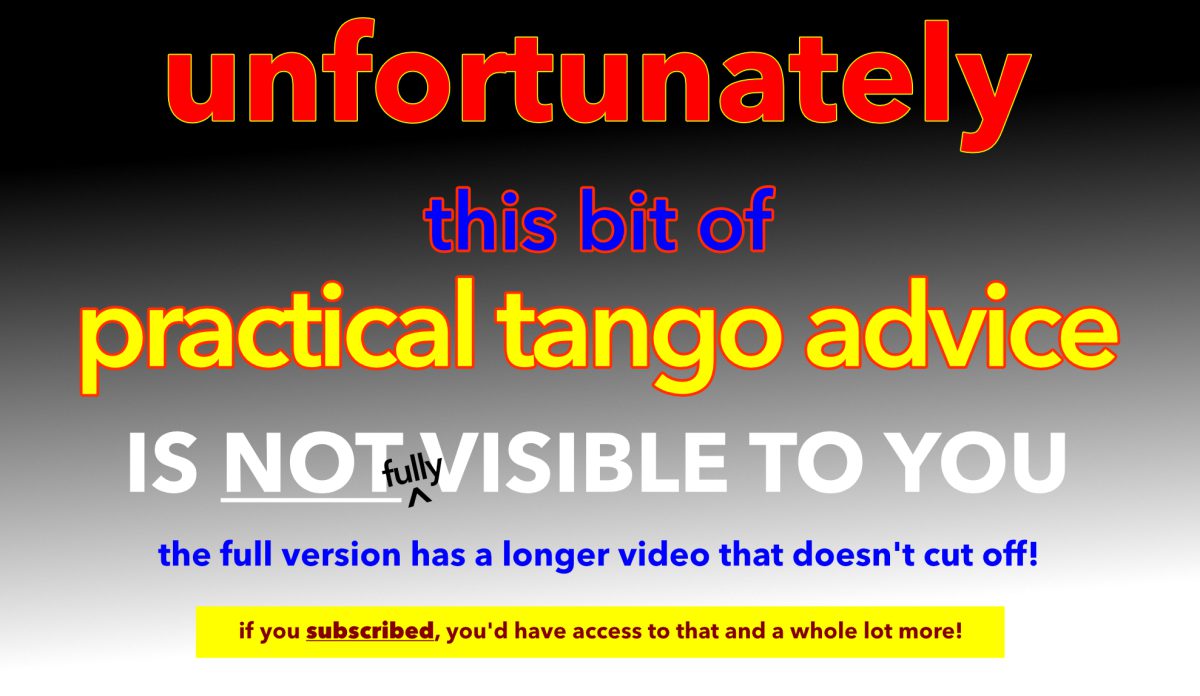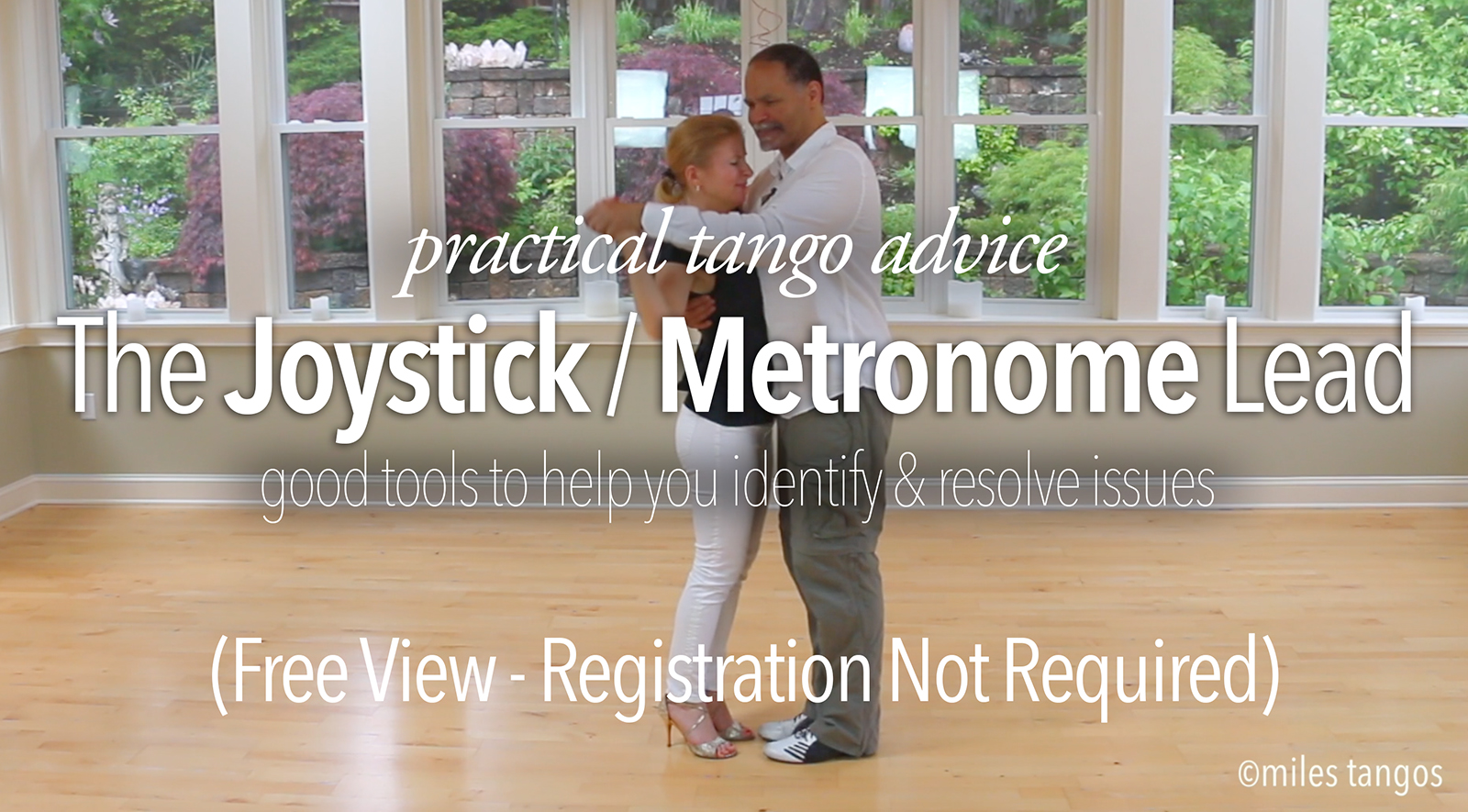It’s been said before many times that Argentine Tango is a very unique dance. It is a very challenging dance to learn and then to dance for a variety of reasons. Mostly your education has been a compromise of your body of how to do things. You’ve been shown X visually, and your understanding X is how to do something visually without a care as to how it feels to have it done to or with you. There’s usually an underlaying method that has not been taught or has been overlooked that can make X look AND feel amazing when done properly. The problem with that is that most people don’t want to learn ‘properly’, it takes far too much time to do something properly, so they take a shortcut which gets the same results and this becomes someone’s way of dancing rather that employing proper execution. Most of the time the issue with X is one of two things: 1.) Someone’s walk. or 2.) Someone’s Embrace. In Free View of Practica Tango Advice, we’re dealing with an embrace issue specifically for the Lead.
Tango gets most of its uniqueness from its embrace format: The very iconic asymmetrical embrace. Few social dances possess such a structure in exactly the same way. Greystone does because it’s borrowed from Tango. Kizomba does to a degree, again, borrowing from Tango heavily. But very few others do. In Today’s Free View of Practica Tango Advice, we discuss an aspect of that iconic embrace that tends to mar the experience for the Follower not necessary for the Lead. Mostly because said ‘Lead’ is completely unaware that they’re using one (or in some cases both, sadly) of these ideas.
That said, let’s dive into the The Joystick/Metronome Lead.
The Joystick Lead, let’s get a few things out of the way first. 1.) this is a purely a Lead thing, it’s not something that a Follower has a whole lot of control over (see below). 2.) truthfully this is all about resistance based dancing.
This type or way of leading is all about using the Follower’s right arm as if it were a ‘Joystick’ (hence where it gets it’s name from) to a video game to control, and quite realistically used to indicate direction, speed, and even certain pieces of vocabulary to the Follower by means of rotating either pulling the Follower’s arm towards or away from the lead. A good portion of the time the lead uses the Follower’s right arm as a means to stop them in concurrance with the lead’s right arm. While this might be considered “La Marca”, it’s not. That’s a slightly different, but somewhat similar, way of engaging the dance from a leading perspective. In the case of “La Marca”, it is done deliberately, consciously, and usually only with the lead’s right forearm and right hand. Never with the left! In the case of The Joystick Lead, it is done unconsciously due a lack of physiological control over the Follower’s motion.
Truthfully this way of dancing happens a good deal more than you might imagine. Sometimes, while it’s depicted in the video in the extreme, the reality is that this type of leading happens quite frequently. Most Followers have experienced this form of leading. How’s that ? Because the resistance based lead is nearly everywhere. And while what’s depicted in the video above is the extreme, what really happens is a push/pull so that the arm doesn’t necessarily move but the pressure to indicate direction and speed is there when it’s not necessarily required or needed.
Is this a desirable thing to do ? No. Obviously. It’s not. The funny thing is that while the practice of the form says that we don’t want to do this, you’re going to continue to do it because it serves your purpose. The fact of the matter is that they only way you’ll stop doing it, is when you’ve had it done to you! And after you’ve woken up the next morning with a sore shoulder because some guy decided to rip your arm out of your shoulder socket, you’re just not going to get the hint. Joystick Leading is only fun for the lead, and not necessarily for the Follower. So let’s be clear about this one: You don’t need it. At all. Ever. However a good number of you don’t or haven’t discovered the joys of Following or see no purpose in it, so therefore you’ll never see the pointlessness of needing to engage any level of this at all. Trust this, not only do you not need it, not only is the lead left arm a visual component only, but the reality is that you don’t need your arms at all in order to dance. We rely on the embrace far too much for stability and to indicate that X is desired and Y is to be executed. A Wild Idea: At your next practica, try a few tandas without the embrace! You will discover that yes, it’s hard, and you’ll feel like you need to hold on to your partner to keep them in front of you. The reality is that the dance is a conversation not a monologue of your thoughts and ideas, and that means that you must ask for something and listen (key word in the sentence) for the response.
The Metronome Lead. From the moment the music starts through the moment it ends, this particular type of lead will instead of keeping the ‘beat’ on the floor, they’ve transmitted that beat depiction to the embrace, and in specific to the Follower’s Right Arm, and the Lead’s Left. Each down beat is an upwards motion, each up beat is a downward motion. Thereby creating an inverse metronome effect. Truthfully you don’t see this type of lead all that often, not in the extreme as shown in the video. However, a good number of leads do actually engage this way of dancing in the minimal.
Is this a desirable thing to do ? No. It’s not. The reality is that you want to keep the beat on the floor and not in the embrace.
From A Following Perspective. There’s not a whole lot you can do about these guys. Honestly. As nice as they are as people, their embrace, and in specific their left arm shenanigans are going to cost you a visit to the chiropractor the next day. That’s the reality. So what can you do about it ? Several things actually, one of which is not depicted at all in the video. It’s to take your arm out of the equation. Remove it. Either drop your right arm which is rude, OR the more appropriate thing is to take his arm and pull it in towards you and place it on his chest and to hold it there. This has the effect of making the dance cozy, and also somewhat intimate. But it’s a viable option to having your arm pulled out of it’s socket! Still another one, which is going to sound mean and rude, but the fact is that you’d like to keep your arm in your socket ready for the lead who can dance with you properly: Say “no thank you” before this happens. You can see this Lead coming a mile away. Honestly it’s not like you’re not aware of this stuff. You’re watching them dance with every one else and you must see it. So the only thing you can do really is to avoid it like the plague. Say “no thank you”. While it won’t stop the Lead from doing it, it will stop it from happening to you! Now if you’d like to go the extra mile and explain why you’re saying “no thank you”, invite them to a practica for a tanda. And while you’re dancing, use the following phase, “I feel a lot of up and down with your arm, I wonder why that is so…” and several variations of that question and statement several times until they get the hint.

The Free Tip & Soup. Typically as a paying subscriber you would see some things here that are either missing in the video, or some other details that the video implies or does not make absolutely clear. However, because this an open version of Practical Tango Advice, you’re seeing all of it here. 😉 Enjoy this free preview of today’s Practical Tango Advice, and remember that this is just a small sample of what else is behind the the paywall of Tango Topics. There’s over 250+ videos, over 1000 pieces of tango music, videos to help you understand the music and what to listen for, tests, quizzes, exercise videos, all for one low fee. Consider either subscribing today or upgrading your subscription!

